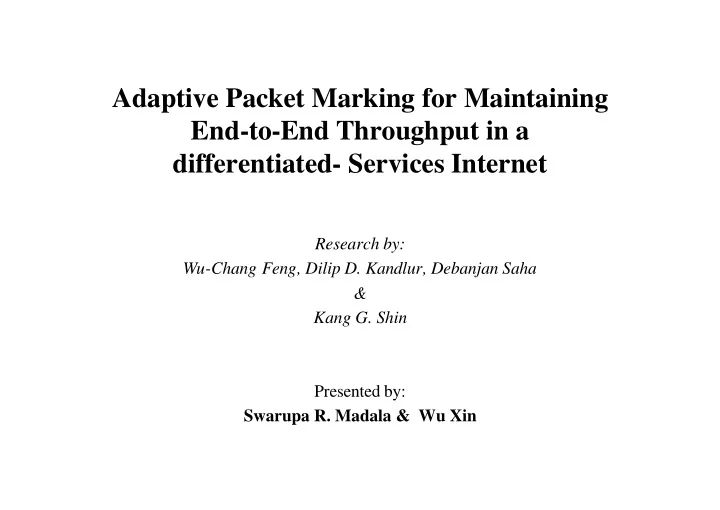

Adaptive Packet Marking for Maintaining End-to-End Throughput in a differentiated- Services Internet Research by: Wu-Chang Feng, Dilip D. Kandlur, Debanjan Saha & Kang G. Shin Presented by: Swarupa R. Madala & Wu Xin
Introduction • IETF’s Architectural Extensions – Different levels of service to different users • Resource Reservation Setup Protocol(RSVP) – Circuit-based QoS Architecture – Needs significant changes to the Infrastructure • Differentiated Services – Simple network core – Complexity in network edges – Packets are classified and marked with appropriate ToS – Routers support priority handling based on ToS at the Core – Difficult to provide throughput guarantee to individual flows.
MODEL • Network Service model with modest enhancement to the best-effort service • Network supports a one-bit priority scheme with lower loss rate for high priority traffic. • Network provides incentives that would discourage users from continually requesting highest level of service • User specified minimum service rate for a connection which is communicated to a control engine at the host network interface. • All connections use TCP protocol
Packet Marking • Control Engine - packet-marking engine (PME) – Monitor and sustain the requested level of service – Sets ToS bits in the packet header appropriately – Default - all packets are low-priority – If Observed service rate >= requested, PME starts prioritizing until desired target rate is reached. • Types of marking – Source-Transparent – Source-Integrated
ToS Architecture • Traffic Type - Priority & Best-effort are carried in the ToS bits in the IP header • Approaches for providing Priority Services – Maintain separate queues for different levels – Common FIFO queue with different drop preferences • Simplifies Scheduling functionality at the router • Helps maintain packet ordering. • FIFO with an Enhanced RED(ERED) algorithm is used for providing service differentiation between priority levels
Source-Transparent Marking • Marking engine is transparent and external to the host • TCP-independent algorithm Every update interval: Scale = | 1-obw/tbw| if(obw < tbw) mprob = mprob+scale*increment else mprob = mprob-scale*increment • Disadvantages – Little control on the flow – Congestion control mechanisms exercised by the source
Source-Integrated Marking • Marking engine is integrated with the host • Adapts better with the flow and congestion control mechanisms used at the transport layer • Receive fair share of the best-effort bandwidth and bandwidth received due to priority packets • Congestion window – Priority window ( pwnd ) – best-effort window ( bwnd ) contd.
After every acknowledgment (opencwnd) After every segment loss from dupack (closecwnd) pwnd = mprob * cwnd bwnd = (1 - mprob) * cwnd pwnd = mprob * cwnd if (obw < tbw) bwnd = (1-mprob) * cwnd if (pwnd < pssthresh) if (priority loss) pwnd = pwnd + pwnd/cwnd cwnd = cwnd / 2 else pwnd = pwnd + 1/cwnd pssthresh = mprob * cwnd if (bwnd < bssthresh) bssthresh = (1 - mprob) * cwnd bwnd = bwnd + bwnd/cwnd else else bwnd = bwnd + 1/cwnd bwnd = bwnd / 2 else bssthresh = bwnd if (pwnd > 0 ) cwnd = pwnd + bwnd if (bwnd < bssthresh) mprob = pwnd / cwnd pwnd = pwnd - bwnd/cwnd else pwnd = pwnd - 1/cwnd else if (bwnd < bssthresh) bwnd = bwnd + bwnd/cwnd else bwnd = bwnd + 1/cwnd if(pwnd <0) pwnd =0 cwnd = pwnd + bwnd mprob = pwnd/cwnd Customized TCP congestion window opening Customized TCP congestion window closing
Handling Over Subscription • All connections carry only marked packets. • ERED queue degenerates into RED queue. • Each source receives an equal fair share of bandwidth.
Weighted-bandwidth sharing • Additional priority bits are used to direct traffic into different ERED queues. • ERED queues are served by using weighted-fair queueing or class-based queueing.
Dealing with Nonresponsive • Nonresponsive flow have a negative impact on the TCP connections • Nonresponsive flow botains all ot the available best –effort bandwidth. • FRED detects the nonresponsive flow and limits its throughput to fair share of the best-effort bandwidth.
When No differentiation supoort • Transparent PME – TCP are not affected as a result of packet marking. – TCP sources behave as if they are operating in a best-effort network.
When No differentiation supoort • Integrated PME – The source keeps track of the interdrop times for both priority and best-effort packets. – If there is a network that does not support priority service. – The source turn off the marking and the windowing algorithm.
Recommend
More recommend